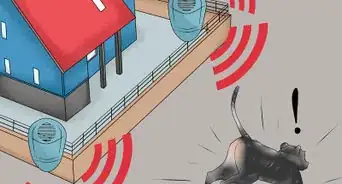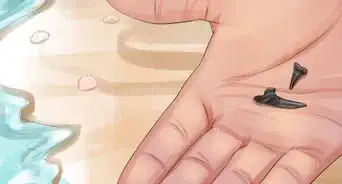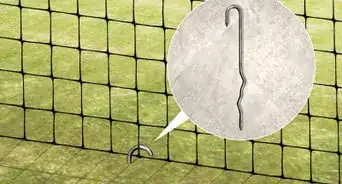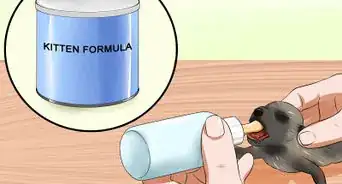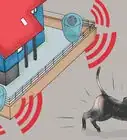This article was co-authored by wikiHow staff writer, Dan Hickey. Dan Hickey is a Writer and Humorist based in Chicago, Illinois. He has published pieces on a variety of online satire sites and has been a member of the wikiHow team since 2022. A former teaching artist at a community music school, Dan enjoys helping people learn new skills they never thought they could master. He graduated with a BM in Clarinet Performance from DePauw University in 2015 and an MM from DePaul University in 2017.
There are 12 references cited in this article, which can be found at the bottom of the page.
Learn more...
Beavers are smart, strong, industrious little critters with a knack for changing their environment to suit their needs—unfortunately, this can cause issues like flooding or felled trees on or around your property. Is it possible to get rid of these animals humanely? With the proper trap, you can snag a beaver safely and transport it to a new habitat where it can dam away without causing you grief. In this article, we’ll show you how to relocate beavers and proof your property against returning bucktoothed visitors. If you’re ready to take a bite out of your beaver problem, keep scrolling!
Things You Should Know
- Check your state’s regulations around trapping and relocating beavers or modifying their habitat before taking any action yourself.
- Set live traps on frequently traveled beaver paths (like lodge entrances) and transport beavers to new habitats 10 mi (16 km) away.
- Repel beavers by dismantling or draining their dams, installing fencing around trees or your yard, or painting tree trunks with latex and sand.
Steps
Trapping & Relocating
-
1Review your state’s regulations about trapping beavers. Contact your state’s Department of Natural Resources or search for beaver trapping guidelines on your state’s website (look for a secure URL ending in “.gov”). There may be restrictions on when and where you can trap beavers and what types of traps you can use.[1]
- It may be illegal to trap beavers outside of their trapping season, if your state has one (typically November or December through March or April).
- Some states regulate whether traps can be lethal or nonlethal, especially if beaver populations are low.
-
2Purchase a nonlethal, cage- or suitcase-style trap. Choose a cage-style trap if you need to remove multiple beavers (they’re cheaper, especially if you need to set more than one trap). They’re also safer for beavers since they’re not spring-loaded. Go for a suitcase-style trap if a cage doesn’t work (suitcases lay flat and are easier to camouflage).[2]
- Suitcase-style traps are more expensive and heavier than cage-style traps, making them less convenient to use.
- Suitcase traps have a spring in the center that triggers 2 jaws with wire mesh to snap together and envelop the beaver. This makes the risk for injury higher.
Advertisement -
3Locate where the beavers are eating or living. Check the waterline of ponds and rivers for gnawed, discarded branches or hourglass-shaped tree stumps. Look for the opening to their lodge, too—usually, it’s a structure made of sticks and mud with a small burrow opening at or under a nearby waterline.[3] Other signs of beaver activity (and potential places for traps) include:
- Dams built from mud, sticks, stones, and vegetation that span narrow waterways (beavers build dams to raise water levels around their lodge).
- Muddy foraging trails that the beavers use to travel between bodies of water or to enter and exit their lodge.
- Beaver footprints (the back feet are larger than the front and have webbed toes).
- Scent mounds (small piles of mud marked with urine or anal glands that may smell slightly like vanilla).
- Beaver droppings (these are hard to find since beavers usually excrete in the water).
-
4Set traps along paths that the beavers frequent. If you found their lodge, try this spot first—set the trap on the entrance or exit path (most lodges have 2 points of entry, unless they’re burrowed into a bank). Also try setting traps at the end of the muddy paths the beavers use to cross over their dam.[4]
- Set traps anywhere beavers eat or roam, too. They’re less successful than traps set on paths, but worth a shot if you have lots of animals to relocate.
- Check your state regulations again. Some states require traps to be set a minimum distance away from a beaver lodge or dam.
- Beavers are habitual animals and like to use the same entrances, exits, and paths over and over again.
-
5Add beaver castor oil or food to the trap as bait. Beavers are attracted to the scent of food or other beavers, so lure them into the trap with beaver castor (a substance beavers secrete to mark their presence) or some of their favorite foods like poplar branches, leaves, or bark.[5]
- Position the bait so the beaver’s whole body and tail will be inside the trap when it engages the trigger.
- Wear gloves when you place the bait so your scent doesn’t deter the beaver from entering the trap.
- Other popular beaver bait includes apples, peanut butter, or other branches and sticks covered in poplar oil.
-
6Open the trap at dusk and check it in the morning. Beavers are largely nocturnal, so keep the trap closed during the daytime to avoid trapping other animals. Open it just before nightfall to catch beavers as they forage for food, gather dam supplies, or make repairs to their dams and lodges.[6]
- At dawn, go back to your trap to look for beavers (and to close it before diurnal animals wander inside of it).
- Check the trap once every 24 hours to prevent the beaver from suffering. In some states, it’s illegal to neglect the trap for longer than this.[7]
- Beavers aren’t usually wary of traps unless they’ve been caught in one before.
-
7Transport the beaver to a body of water at least 10 miles (16 km) away. Once you’ve caught a beaver, keep it in the trap and drive it to another watery habitat far enough away that it won’t wander back to your property. Wear protective gloves the entire time to protect your hands from bites and scratches through the wire.[8]
- If you’re relocating multiple beavers, release them in the same area so families and social groups can stay together.
- Ask a friend to help you maneuver the trap if needed. They can be heavy and hard to lift alone, especially with a beaver inside.
- Contact your Department of Natural Resources if the beaver appears injured or rabid in the trap. It may not be fit to move according to state regulations.
-
8Call a licensed wild animal control operator. If you’d rather not deal with trapping or repelling beavers yourself, look up a list of approved animal control specialists through your state’s Department of Natural Resources. In most cases, these specialists will trap and relocate beavers safely and humanely and show you how to beaver-proof your property and surrounding land.[9]
Repelling New Beavers
-
1Dismantle all remaining dams and lodges. Once the beavers are gone, wade into the water (if it’s safe) and use a rake or shovel to make holes in the dam to allow water to flow through. Remove loose sticks, stones, and other construction materials by hand and chop up large wooden pieces so they can’t be used again.[10]
- It may take several days to tear down the dam with a shovel or rake, so come back every day until it’s completely leveled.
- Alternatively, rent and use a backhoe to tear the dam down in one session (if the machinery can safely reach the dam in the water).
- Tap around the dam and lodge with your shovel to make sure there are no beavers inside before you begin tearing them down.
- Some people say that blasting the dam with explosives is the best way to demolish it, but the safety and legal concerns make this a tricky option.
-
2Wrap nearby tree trunks in cylinder cages. Measure the circumference of each tree and add 1 ft (0.30 m), then cut that length from a roll of wire fencing. Put on protective gloves and cut every other horizontal wire at one end of the fencing with wire snips, then wrap the fence around the tree trunk. Bend the cut wires into hooks to secure the fence.[11]
- Choose fencing with mesh openings that are 2-4 in (5.1-10.2 cm) wide. The fencing should be at least 3 ft (0.91 m) high.
- Encircle the entire trunk and leave at least 6 in (15 cm) between the tree and the cage so the tree has room to grow.
- If needed, anchor the cages to the ground with stakes to keep beavers from pushing them down. Tree cages can last for many years.
- When beavers can’t eat or use trees for construction, they’re likely to move on to a new area.
-
3Set up exclusion fences to keep beavers out. If you want to protect marine life in a pond, set up a 6 ft (1.8 m) high fence around the water to keep beavers out (they can’t climb). Consider fencing in your yard or small patches of land and regularly clearing up fallen branches to discourage beavers from looking for construction materials on your property.[12]
- For large areas, consider hiring a professional to install electric fencing. This requires some maintenance since you have to monitor the electricity supply.
- If you get electric fencing, regularly check for and remove fallen branches on the fence (they could catch fire).
-
4Paint tree trunks with a mix of sand and latex. Combine 8 oz (226.8 g) of masonry sand with 1 qt (0.96 L) of exterior grade latex paint and paint the mixture about 4 ft (1.2 m) high up the trunks of trees. Renew the paint job every 2-3 years as needed to keep beavers from gnawing on trunks.[13]
- Skip the paint on newly planted trees that are less than 6 ft (1.8 m) high.
- If you’re picky about colors, ask a paint store to match a latex paint to the color of your tree bark.
- The latex allows the tree to breathe enough to stay healthy while the sandy texture discourages beavers from chomping down.
-
5Install a drain pipe in the dam to force beavers to move away. Make a hole through the beavers’ dam with a shovel and feed a long length of pipe at least 4 in (10 cm) wide through it. The beavers will repair the hole you made, but won’t know to plug up either end of the pipe. This ruins their ability to control water levels and may force them to relocate on their own.[14]
- Choose corrugated, single wall ABS pipes that are flexible enough to maneuver around underwater obstructions.
- Place the ends of the pipe as far away from the dam as you can. When beavers feel running water, their instinct to patch up the hole kicks in.
- This method will also prevent flooding caused by the dam if that’s an issue.
Warnings
- Beavers will attack when they get defensive. Don’t approach a beaver unless it is secure in a trap to avoid scratches, bites, and other injuries.[15]⧼thumbs_response⧽
References
- ↑ https://pestcontrolhacks.com/how-to-trap-a-beaver/
- ↑ https://www.aphis.usda.gov/wildlife_damage/reports/Wildlife%20Damage%20Management%20Technical%20Series/Beaver-WDM-Technical-Series.pdf
- ↑ https://life-beaver.eu/en/about-beaver/how-to-identify-the-presence-of-beavers/
- ↑ https://www.trap-anything.com/beaver-trapping-techniques.html
- ↑ https://www.forestwildlife.org/how-to-get-rid-of-a-beaver-in-your-yard/
- ↑ https://wildlifecontroltraining.com/training/trapping/
- ↑ https://georgiawildlife.com/regulations/trapping
- ↑ https://www.forestwildlife.org/how-to-get-rid-of-a-beaver-in-your-yard/
- ↑ https://www.in.gov/dnr/fish-and-wildlife/wildlife-resources/animals/beaver/
- ↑ https://wildlife-damage-management.extension.org/what-is-the-best-way-to-remove-a-beaver-dam/
- ↑ https://lakebarcroft.org/community/environmental-quality/beaver-damage-tips
- ↑ http://wildlifehumane.org/animals/beavers/get-rid-of-beavers
- ↑ https://lakebarcroft.org/community/environmental-quality/beaver-damage-tips
- ↑ https://www.wildliferemoval.com/how-to-get-rid-of-beavers/
- ↑ http://wildlifehumane.org/animals/beavers/get-rid-of-beavers













